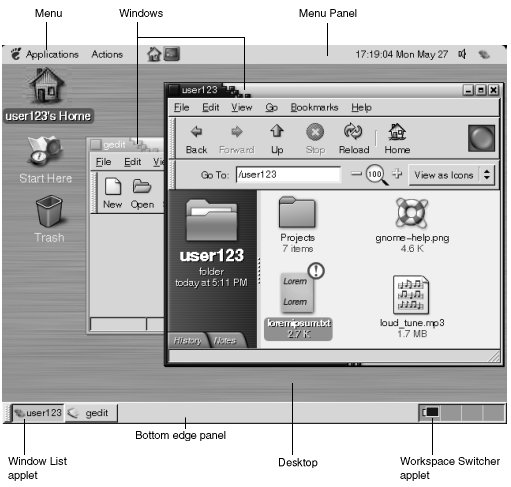Introducing Desktop Environment Components
When you start a desktop environment session for the first time, you should see a default startup screen, with panels, windows, and various icons. Figure 2–1 shows a typical desktop environment.
Figure 2–1 A Typical Desktop Environment

The major components of the desktop environment are as follows:
-
Panels
Panels are areas in your desktop environment from which you can access all of your system applications and menus. Panels are very configurable. A particularly important panel in Figure 2–1 is the Menu Panel. The Menu Panel stretches the full width of the top edge of the screen. The Menu Panel includes two special menus, as follows:
-
Applications menu: Contains all applications and configuration tools. This menu also includes the file manager and the help browser. To start the file manager, choose Home Folder from the Applications menu.
-
Actions menu: Contains various commands that perform desktop environment functions, for example Search for Files and Log Out.
Click on the icon at the extreme right of the Menu Panel to display a list of all open windows.
-
-
Menus
You can access all desktop environment functions through menus. The Menu Panel contains menus, so you can use a combination of menus and panels to perform your tasks. You can use the Applications menu and the Actions menu to access almost all of the standard applications, commands, and configuration options.
You can also access almost all of the standard applications, commands, and configuration options from the GNOME Menu. You can access the items in the Applications and Actions menus from the GNOME Menu. You can add the GNOME Menu as a button to your panels.
-
Windows
You can display many windows at the same time. You can run different applications in each window. The window manager provides frames and buttons for windows. The window manager enables you to perform standard actions such as move, close, and resize windows.
-
Workspaces
You can subdivide your desktop environment into separate workspaces. A workspace is a discrete area in your desktop environment in which you can work. You can specify the number of workspaces in your desktop environment. You can switch to a different workspace, but you can only display one workspace at a time.
-
Nautilusfile managerThe
Nautilusfile manager provides an integrated access point to your files and applications. You can display the contents of your files within aNautiluswindow, or open the files in the appropriate application fromNautilus. You can use the file manager to manage your files and folders. -
Desktop
The desktop lies behind all of the other components in the desktop environment. The desktop is an active component of the user interface. You can place objects on the desktop to quickly access your files and directories, or to start applications that you use often. You can also right-click on the desktop background to open a menu.
-
Start Here location
The Start Here location provides an access point to some of the key features of the desktop environment. You can access your GNOME applications and configuration tools from the Start Here location. You can also access programs that enable you to configure your system as a server, and to choose other system settings.
-
Desktop environment preferences
The desktop environment contains dedicated preference tools. Each tool controls a particular part of the behavior of the desktop environment. To start a preference tool, choose Applications -> Desktop Preferences. Choose the item that you want to configure from the submenus.
The most powerful features of the desktop environment are the high degree of configurability and the multiple ways that you can perform tasks.
The desktop environment provides interoperability of the desktop environment components. Usually, you can perform the same action in several different ways. For example, you can start applications from panels, from menus, or from the desktop.
Your system administrator can make configuration changes to suit your needs, so that the desktop environment might not be exactly the same as described in this chapter. Nevertheless, this chapter provides a useful quick guide to how to work with the desktop environment.
- © 2010, Oracle Corporation and/or its affiliates
